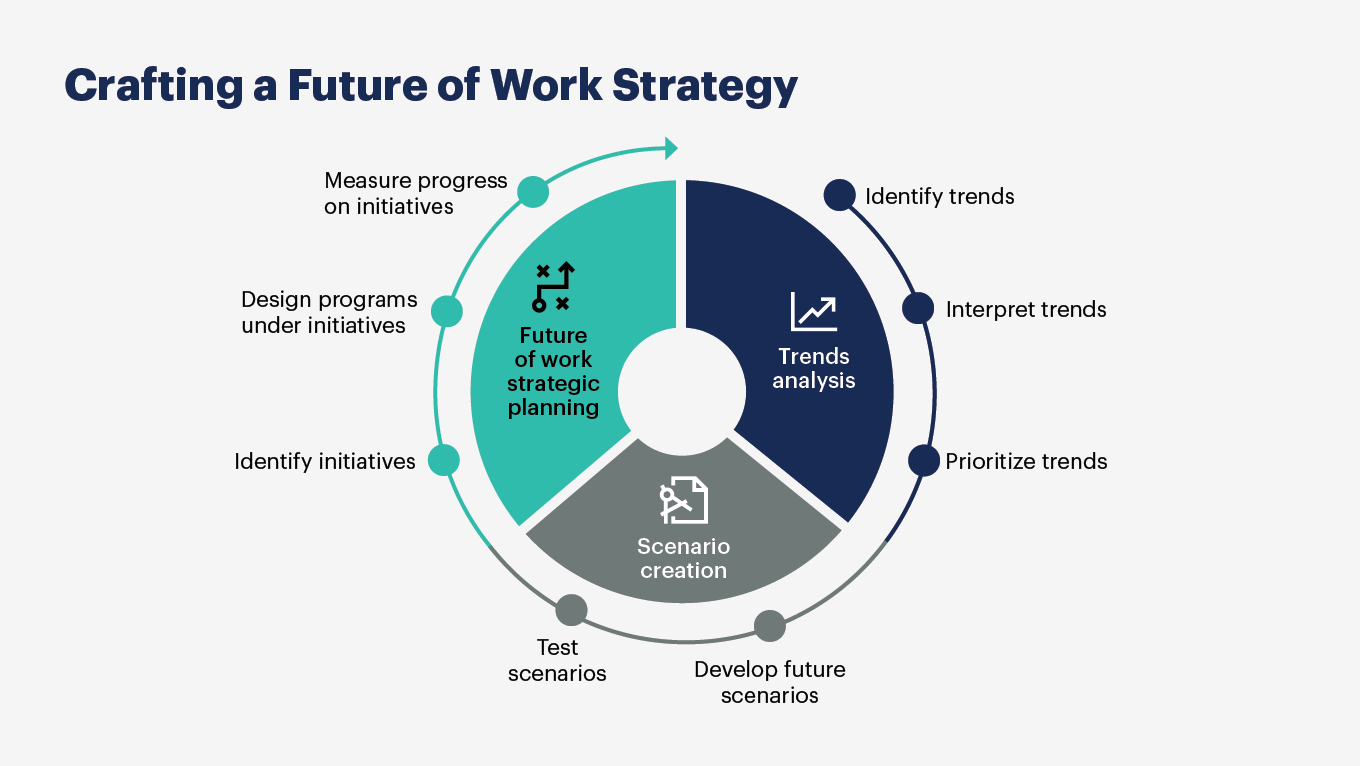
How to Craft a Highly Effective Future of Work Strategy
Determine the right approach for formalizing the future of work at your organization by following these key principles and processes.
Why CHROs must develop a strategy for the future of work
The future of work requires an integrated planning process that equips HR organizations for the uncertainty and implications of future events — such as changing workforce needs, growing talent gaps, new cost control measures and emerging disruptive technologies — all while aligning HR strategy with business strategy.
HR leaders can build a resilient, future-ready workforce by shaping strategy around the organization’s goals, anticipating critical opportunities and obstacles, and planning initiatives to respond effectively.
Craft a future of work strategy that navigates change proactively
For every organization, disruptive events and trends — both internal and external — can quickly lead to sweeping changes to the business model, operations, labor force or supply chain. Whether those changes present exciting opportunities or existential threats, a clear future of work strategy helps an organization respond and thrive.
Approach the future of work strategy with a focus on impact
Identifying, interpreting and prioritizing trends is key to planning for the future of work.
- Scope existing trends from external sources (such as outside experts or press reports) and internal sources (such as talent analytics or board and executive meeting minutes).
- Identify hidden potential trends by envisioning the future and working backward to what must take place for that future to happen.
- Prioritize where best to focus. Evaluate a trend’s relevance according to its level of uncertainty and power to drive transformation. Identify organizational factors that will accelerate or inhibit each trend’s impact. Prioritize trends that will have the greatest potential impact for opportunity or competitive advantage in your talent market or even in your operations.
Develop strategic scenarios to navigate future uncertainties
After prioritizing future of work trends, weigh a range of outcomes and use them to create future business scenarios that will highlight critical uncertainties and business implications. Use storytelling to build simple, relatable narratives that illustrate the trend’s business impact in the scenarios.
With those insights in hand, identify the events that must or must not happen for each scenario to unfold. This helps define a path from the current state to future scenarios, making it possible to monitor whether things are evolving to favor one scenario over another. Assess the likelihood of possible events to help prioritize the scenarios with the highest probability of occurring and highest degree of disruption.
Build a strategic plan to track future of work initiatives
Once scenario and trend prioritization is complete, it’s time to decide what initiatives will go into your future of work strategy, with the goal of creating an adaptive, responsive roadmap.
Analyze the current business strategy against prioritized future scenarios and trends to identify your biggest risks.
Choose the most relevant future of work initiatives to address the risks. Bringing in a wide variety of perspectives, potentially even crowdsourcing ideas from employees.
Break down each initiative into programs with specific objectives and timelines, assign teams and determine the resources required to implement each program.
Select metrics and monitoring mechanisms to track progress on the initiatives and trigger course corrections as needed. This will help keep your future of work strategy impactful as trends evolve.
Formalize the future of work strategy across the organization
Organizations often prepare for the future in silos. This fragmented approach raises significant risks, such as conflicting business unit priorities, redundancies in processes and efforts, and misalignment with organizational goals — all of which have severe cost implications.
Having a central framework for individual business units creates shared accountability and responsibility toward a single goal. Adopt a unified future of work strategy to gain a competitive edge in the industry and labor market, surface innovative ideas, accelerate action during times of disruption and enhance employee engagement and employer branding.
Future of work strategy FAQ
Why is it important for HR leaders to develop a future of work strategy?
Developing a future of work strategy is crucial for HR leaders because it helps align HR planning with business goals, prepares the organization for uncertainties and addresses changing workforce needs, talent gaps and emerging technologies. This proactive approach ensures that the organization can respond effectively to both opportunities and challenges.
How can organizations prioritize trends when planning for the future of work?
Organizations can prioritize trends by evaluating their relevance based on uncertainty and potential to drive transformation. This involves identifying internal and external trends, assessing their impact on the organization and focusing on those with the greatest potential for opportunity or competitive advantage. Creating scenarios and narratives can further help in understanding the implications of these trends.
What are the benefits of having a unified future of work strategy across an organization?
A unified future of work strategy helps avoid risks associated with fragmented planning, such as conflicting priorities and redundancies. It fosters shared accountability, enhances employee engagement and improves employer branding. Additionally, it enables the organization to act swiftly during disruptions and maintain a competitive edge in the industry and labor market.
